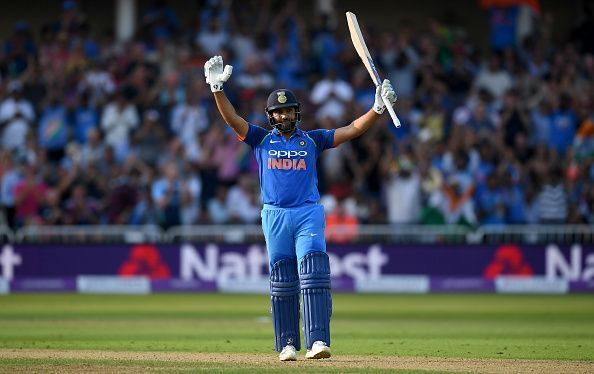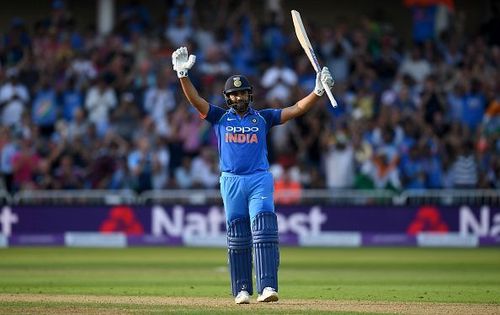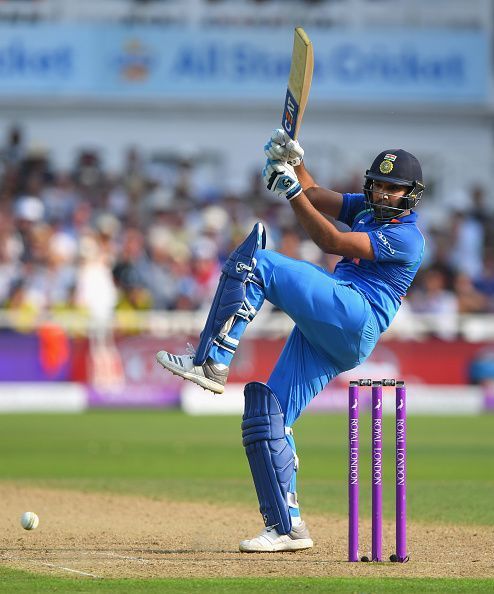
A case for Rohit Sharma to bat at 4 in ODI Cricket

This is not the first time you have read a piece contemplating the idea. For all it is worth, you, as a passionate follower of Indian cricket, may have already entertained the notion, advocated it, or may have rejected it outright. But you also realize that the clock's ticking, a mere 8 months are all that remain.
There are only 21 more One-Day Internationals to play. There is no hiding from the fact that the Indian senior men's cricket team is no closer to finalizing the batting order than it was a year ago. It is time to act, it is time to show faith in a few men who will carry the nation's hopes. It is time to zero in on a man who will walk out at the fall of the second wicket.
Rohit Sharma finds himself an important man in the scheme of things. Not only is he part of the Indian team's formidable top 3, but he is also the vice-captain, a role into which he has grown since his appointment a shade over a year ago. He is crucial to the team's chances in the showpiece event both as a gun batsman and in his leadership role.
Since the last 50 over World Cup in Australia, India's top 3 have scored a tinge over 60% of the runs scored by the team which is comfortably the best showing in this period in world cricket. They have dominated many an opposition both batting first and perhaps more spectacularly while hunting down totals, small and daunting alike. However, as has been evident, this has created an over-dependence on the trio consisting of Shikhar Dhawan, Virat Kohli and the subject of this piece Mr. Sharma.
These men are not only tasked with providing a sound platform for an innings but to also motor through the middle overs and one of them must also ensure the fireworks between overs 41-50 to propel the team to a big total.
Statistics might not ever tell us the complete story but they do map out cold hard truths in black and white. It tells us that the returns of the middle order suggest that as a compartmentalized unit it does not belong to a team which is at the moment the best in the world and has aspirations of winning its second World Cup of the decade and thus having designs on the title of the best 50 over team since the formidable Australian side of the "noughties".
Since the 2015 World Cup, the middle order has accounted for a sorry 33% of runs scored, making it the worst performing middle order among the top 10 teams in ODI Cricket in this duration. While this may be attributed to the run-scoring prowess of the top 3, it is the abject performance of the unit which sticks out like a sore thumb when two of the iconic trio do not bat through most of the middle overs and when none of them sticks around for the last 10 overs.
So reliant is the team on the trio that India have made only one 300 plus score without a 50 from either Dhawan, Rohit or Kohli in the last 3.5 years. There have been instances galore when the middle order has thrown away starts of 150 plus to end up with a below-par score, unable to maintain the run rate and also botching quite a few chases from such positions of strength.
The picture is even worse when in the rare instances, the top 3 collectively did not fire. The middle order have, in such matches, failed at their primary job of rebuilding in the middle overs and have not managed to put up match winning totals. The key stat observable here is the failure to maintain a healthy run rate north of 5 runs per over which is a reasonable yardstick considering the early loss of the top order and the average totals in the modern game.
Without the services of one of the three top order batsmen in the business end of an innings, overs 41-50, the run rate has never climbed past 7 runs an over in the last 3 and a half years. To score over 8.5 an over and get close to a hundred runs from these overs, one of these 3 men in the middle has been an absolute necessity. The men expected to be doing the job at this stage in the innings have had high dot-ball percentages hovering in the high thirties in the overs between 41 and 50 thus making it increasingly difficult to get the job done.
The man who has the best strike rate in these overs is none other than Rohit Sharma who strikes at a superhuman 197 with a boundary every 4 balls while maintaining an impressively low dot-ball percentage of 13. These numbers make him one of the best in the world in the death overs. It would be in the best interests of the team to have this man out in the middle at the death more often.
For that to transpire more frequently, a move to no. 4 would not be ill-advised. It would serve the purpose of bolstering the fragile middle order keeping in mind the fact that none of the batsmen who have so far auditioned for the role since the last World Cup have made the position their own, right from the residue of 2015, Ajinkya Rahane, the recalled and promptly discarded Yuvraj Singh to the current hopefuls, Manish Pandey, Ambati Rayudu, K.L Rahul, and Shreyas Iyer.
Even the talismanic M.S Dhoni fancied the position for 10 odd knocks without much success. With Rohit for company, numbers 5 to 7 would find life easier and in all likelihood, be better able to express themselves freely, as has been the case whenever one of him, Kohli and Dhawan has batted through the innings.

In ODI cricket, the no 4 batsman is the bridge between the top order and the finishers which requires a very skillful batsman who can take the baton off the top 3 and maintain the run rate with minimal risk throughout the middle overs and eventually provide a launchpad to the big-hitting men who await their chance to tee off at the death.
This move would create a vacancy for the outrageously talented opener K.L Rahul who can comfortably match Rohit's exploits in the top order with the talent he possesses and the prowess he has displayed since he warmed to white ball cricket.
Rohit has performed a similar role for Mumbai Indians over the years in the IPL successfully, scoring over 2000 runs with 19 half centuries albeit it being a different format of the sport. He has managed to strengthen a relatively weak middle order devoid of experience. Thus he has recent experience of performing the role which is crucial and would mean him needing little time to adjust to the position for India.
This move would never be imposed on him considering his super success in his current position and the management would not want to disturb the wildly successful opening pair of Dhawan and him who in the past 5 years have become the world's best combination at the top of the order and are well poised to match the numbers of the all-time great pairs in the format.
It would probably have to be initiated by the man himself. With his position in the leadership and his ever-growing sense of responsibility towards the team which he has been demonstrating on and off the field, such a selfless manoeuvre might not be beyond his vision for the team.